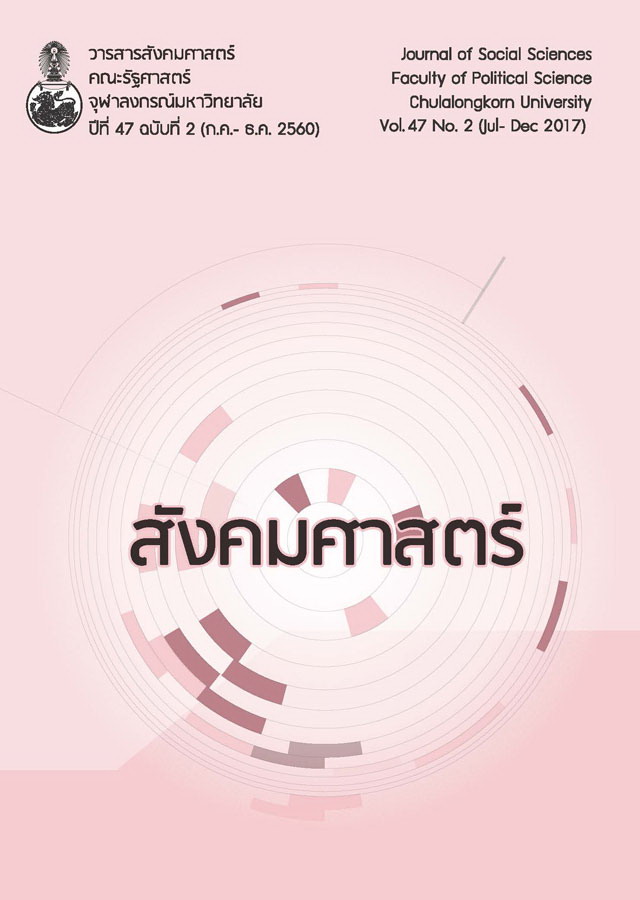ปรัชญาเศรษฐกิจพอเพียง: บทวิเคราะห์เชิงปรัชญา
DOI:
https://doi.org/10.61462/cujss.v47i2.777คำสำคัญ:
พระบาทสมเด็จพระปรมินทรมหาภูมิพลอดุลยเดช, ปรัชญาของเศรษฐกิจพอเพียง, พระพุทธศาสนาเชิงวิทยาศาสตร์บทคัดย่อ
ฐานคิดที่รองรับการวิเคราะห์มโนทัศน์และความคิดต่าง ๆ ภายในปรัชญาของเศรษฐกิจพอเพียง คือแนวคิดที่ว่าปรัชญาของเศรษฐกิจพอเพียงน่าจะประกอบด้วยความคิดพื้นฐานสองชุดคือ หลักคำสอนของพระพุทธศาสนา และ แนวคิดเกี่ยวกับวิทยาศาสตร์ ความสอดคล้องกันในเนื้อหาความคิดระหว่างวิทยาศาสตร์และพระพุทธศาสนานี้ได้มีการกล่าวถึงมานาน โดยเฉพาะในประเด็นเกี่ยวกับความสัมพันธ์ทางเหตุ-ผลในประสบการณ์ของมนุษย์ แต่ก็จำเป็นต้องยกระดับของความสอดคล้องนี้ขึ้นมาหากเราต้องการเข้าใจและเห็นผลในเชิงปฏิบัติของการเชื่อมกันของระบบความคิดทั้งสอง และปรัชญาของเศรษฐกิจพอเพียงก็เป็นตัวอย่างของการยกระดับความเข้าใจในความสอดคล้องดังกล่าว ข้อความหลักในการวิเคราะห์นี้คือการกล่าวถึงความพอเพียงในแง่ของการมีเพียงพอต่อการดำรงชีวิต มโนทัศน์เพื่อการวิเคราะห์ที่สำคัญประกอบด้วยความรู้จักประมาณ (หรือความพอดี) การใช้เหตุผล และทางสายกลาง ซึ่งจะทำให้เข้าใจแนวคิดเกี่ยวกับความพอเพียง และในระดับที่เป็นจริยธรรมสังคมนั้น มโนทัศน์เหล่านี้ได้ถูกนำมาผูกโยงกันกับแนวความคิดเรื่องหน้าที่ของมนุษย์ที่มีต่อผู้อื่นและระหว่างกันเพื่อประโยชน์ของสังคม
Downloads
เอกสารอ้างอิง
Bacon, Francis. 2000. The new organon, eds. Lisa Jardine, and Michael Silverthorne. Cambridge: Cambridge University Press.
Bhumibol Adulyadej, King of Thailand. 1998a. “Royal Speech on Wednesday, December 4, 1974.” In Royal Speech on December 4, 1974, 1975, 1976, 1977, 1978. Bangkok: Amarin Printing and Publishing.
-----. 1998b. “Royal Speech on Saturday, December 4, 1976.” In Royal Speech on December 4, 1974, 1975, 1976, 1977, 1978. Bangkok: Amarin Printing and Publishing.
-----. 1998c. “Royal Speech on Monday, December 4, 1978.” In Royal Speech on December 4, 1974, 1975, 1976, 1977, 1978. Bangkok: Amarin Printing and Publishing.
-----. 1999. Royal Speech on Friday, December 4, 1998. Bangkok: Amarin Printing and Publishing.
-----. 2009. Phra-barom-rachovas lae phra-rajadhamras keiyw-kab sasana lae siladham. [Royal address and royal speech of His Majesty King Bhumibol Adulyadej on religion and morality]. Bangkok: Department of Religious Affairs, Ministry of Culture. (in Thai).
Chalmers, A. F. 1999. What is this thing called science? 3rd ed. Indianapolis: Hackett Publishing Company.
Cohen, Morris R., and Ernest Nagel. 1968. An introduction to logic and scientific method. New Delhi: Allied Publishers Limited.
Derry, Gregory N. 1999. What science is and how it works. Princeton, NJ: Princeton University Press.
Edelstein, Ludwig. 1966. The meaning of Stoicism. Cambridge, Mass.: Harvard University Press.
Harvey, Peter. 1992. An introduction to Buddhism: Teachings, history and practices. Cambridge: Cambridge University Press.
Kanchanapisek Network. 1999. “Biography of His Majesty King Bhumibol Adulyadej.” The Golden Jubilee Network Online Mass-Educational Project. http://www.kanchanapisek.or.th/biography/index.en.html. (Accessed on May 13, 2015).
Khantipãlo, Bhikkhu, trans.1986. A criterion of true religion: Lord Buddha's discourse to the Kalama People (Kãlãma Sutta). Bangkok: Mahãmakut Rãjavidyãlaya Press.
Kuhn, Thomas S. 1996. The structure of scientific revolutions. 3rd ed. Chicago: The University of Chicago Press.
Kyabgon, Traleg. 2014. The essence of Buddhism: An introduction to its philosophy and practice. Boston, MA: Shambhala.
Lopez, Donald S. 2008. Buddhism and science: A guide for the perplexed. Chicago, IL: University of Chicago Press.
Sellars, John. 2006. Stoicism. Durham: Acumen.
Thera, Nyanaponika, ed. 2008. Advice to Rãhula: Four discourses of the Buddha. Kandy, Sri Lanka: Buddhist Publication Society.
Wallace, B. Alan. 2003. Buddhism and science: Breaking down the barriers. In Buddhism and science: Breaking new ground. ed. B. Alan Wallace, 1-29. New York, NY: Columbia University Press.
ดาวน์โหลด
เผยแพร่แล้ว
รูปแบบการอ้างอิง
ฉบับ
ประเภทบทความ
สัญญาอนุญาต
ลิขสิทธิ์ (c) 2017 คณะรัฐศาสตร์ จุฬาลงกรณ์มหาวิทยาลัย

อนุญาตภายใต้เงื่อนไข Creative Commons Attribution-NonCommercial-NoDerivatives 4.0 International License.
เงื่อนไขการอนุญาตสาธารณะ
นโยบายลิขสิทธิ์และการอนุญาต
วารสารสังคมศาสตร์ จุฬาลงกรณ์มหาวิทยาลัย เผยแพร่เนื้อหาทั้งหมดภายใต้ สัญญาอนุญาตครีเอทีฟคอมมอนส์แบบแสดงที่มา-ไม่ใช้เพื่อการค้า-ไม่ดัดแปลง 4.0 นานาชาติ (CC BY-NC-ND 4.0)
ลิขสิทธิ์
บทความทั้งหมดที่ตีพิมพ์ในวารสารสังคมศาสตร์ จุฬาลงกรณ์มหาวิทยาลัย เป็นลิขสิทธิ์ของ คณะรัฐศาสตร์ จุฬาลงกรณ์มหาวิทยาลัย ผู้เขียนจะโอนสิทธิ์ทั้งหมดให้แก่วารสารเมื่อบทความได้รับการตอบรับให้ตีพิมพ์
สัญญาอนุญาต CC BY-NC-ND 4.0
ภายใต้สัญญาอนุญาตนี้:
-
แสดงที่มา (BY): ผู้ใช้ต้องแสดงที่มาโดยอ้างอิงถึงผู้เขียน คณะรัฐศาสตร์ จุฬาลงกรณ์มหาวิทยาลัย และวารสารสังคมศาสตร์ จุฬาลงกรณ์มหาวิทยาลัย พร้อมทั้งให้ลิงก์ไปยังสัญญาอนุญาต และระบุหากมีการเปลี่ยนแปลง ทั้งนี้สามารถทำได้ในลักษณะที่สมเหตุสมผล แต่ต้องไม่ทำในลักษณะที่แสดงว่าผู้อนุญาตให้การรับรองผู้ใช้หรือการใช้งานดังกล่าว
-
ไม่ใช้เพื่อการค้า (NC): ผู้ใช้ไม่สามารถใช้เนื้อหาเพื่อวัตถุประสงค์ทางการค้า การใช้งานเชิงพาณิชย์จะต้องได้รับอนุญาตเป็นลายลักษณ์อักษรล่วงหน้าจากผู้เขียนและคณะรัฐศาสตร์ จุฬาลงกรณ์มหาวิทยาลัย
-
ไม่ดัดแปลง (ND): หากผู้ใช้นำเนื้อหาไปรวม ดัดแปลง หรือต่อยอด ผู้ใช้ไม่สามารถเผยแพร่งานที่ดัดแปลงนั้นได้ การดัดแปลงผลงานจะต้องได้รับอนุญาตเป็นลายลักษณ์อักษรล่วงหน้าจากผู้เขียนและคณะรัฐศาสตร์ จุฬาลงกรณ์มหาวิทยาลัย
นโยบายการเข้าถึงแบบเปิด
วารสารสังคมศาสตร์ จุฬาลงกรณ์มหาวิทยาลัย ให้การเข้าถึงเนื้อหาแบบเปิดโดยทันทีตามหลักการที่ว่าการทำให้งานวิจัยสามารถเข้าถึงได้อย่างเสรีแก่สาธารณะจะสนับสนุนการแลกเปลี่ยนความรู้ในระดับโลก ผู้ใช้สามารถอ่าน ดาวน์โหลด คัดลอก เผยแพร่ พิมพ์ ค้นหา หรือเชื่อมโยงไปยังเนื้อหาฉบับเต็มของบทความได้โดยไม่ต้องขออนุญาตล่วงหน้าจากผู้จัดพิมพ์หรือผู้เขียน ทั้งนี้เป็นไปตามสัญญาอนุญาต CC BY-NC-ND 4.0
นโยบายการเก็บบันทึกด้วยตนเอง
ผู้เขียนสามารถเก็บบันทึกบทความฉบับตีพิมพ์สุดท้าย ต้นฉบับที่ส่ง (preprint) หรือฉบับที่ผ่านการประเมิน (postprint) ในคลังสถาบันหรือเว็บไซต์ส่วนตัวได้ โดยต้องมีการอ้างอิงการตีพิมพ์ครั้งแรกในวารสารสังคมศาสตร์ จุฬาลงกรณ์มหาวิทยาลัย พร้อมระบุแหล่งอ้างอิงที่สมบูรณ์และลิงก์ไปยังเว็บไซต์ของวารสาร
การขออนุญาต
สำหรับการใช้งานนอกเหนือจากที่ครอบคลุมโดยสัญญาอนุญาต CC BY-NC-ND 4.0 กรุณาติดต่อ:
กองบรรณาธิการ
วารสารสังคมศาสตร์ จุฬาลงกรณ์มหาวิทยาลัย
คณะรัฐศาสตร์ จุฬาลงกรณ์มหาวิทยาลัย
Email: cusocscij@gmail.com
สำหรับข้อมูลเพิ่มเติมเกี่ยวกับสัญญาอนุญาตครีเอทีฟคอมมอนส์แบบแสดงที่มา-ไม่ใช้เพื่อการค้า-ไม่ดัดแปลง 4.0 นานาชาติ กรุณาเยี่ยมชม: https://creativecommons.org/licenses/by-nc-nd/4.0/deed.th





